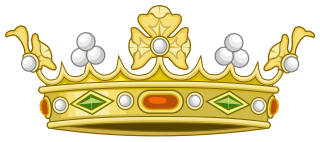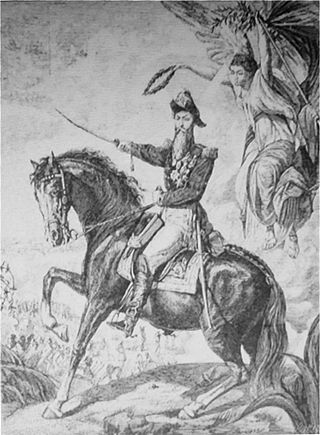
Antonio Leocadio Guzmán Blanco was a Venezuelan military leader, statesman, diplomat and politician. He was the president of Venezuela for three separate terms, from 1870 until 1877, from 1879 until 1884, and from 1886 until 1887 and General during the Venezuelan Federal War.

Apure State is one of the 23 states of Venezuela. Its territory formed part of the provinces of Mérida, Maracaibo, and Barinas, in accordance with successive territorial ordinations pronounced by the colonial authorities. In 1824 the Department of Apure was created, under jurisdiction of Barinas, which laid the foundations for the current entity. In 1856 it separated from Barinas and for the first time Apure appeared as an independent province, which in 1864 acquired the status of state. In 1881, however, a new territorial division combined Apure and Guayana to form a single state named Bolívar. In 1899 it reestablished its autonomy and finally, by means of the Constitution of 1909, gained its current borders.

Guárico State is one of the 23 states of Venezuela. The state capital is San Juan de Los Morros and the largest city is Calabozo, other important city centers include Valle de la Pascua and Zaraza. Guárico State covers a total surface area of 64,986 km2 (25,091 sq mi) and, in 2011, had a census population of 747,739. It is named for the Guárico River.

Táchira State is one of the 23 states of Venezuela. The state capital is San Cristóbal.

José Campeche y Jordán, is the first known Puerto Rican visual artist and considered by art critics as one of the best rococo artists in the Americas. Campeche y Jordán loved to use colors that referenced the landscape of Puerto Rico, as well as the social and political crème de la crème of colonial Puerto Rico.
José is a predominantly Spanish and Portuguese form of the given name Joseph. While spelled alike, this name is pronounced very differently in each of the two languages: Spanish ; Portuguese.
Venezuelan literature is the literature written by Venezuelans or in Venezuela, ranging from indigenous pre-Hispanic myths to oral or written works in Spanish or other languages. The origins of Venezuelan written literature are usually held to date back to the documents written by the first Spanish colonizers, its date of birth being sometimes set at August 31, 1498, when Christopher Columbus called the Venezuelan territory in his Diaries "Tierra de gracia".

The National Pantheon of Venezuela is a final resting place for national heroes. The Pantheon was created in the 1870s on the site of the ruined Santísima Trinidad church from 1744 on the northern edge of the old town of Caracas, Venezuela.
Gonzalo de Salazar was an aristocrat, and leader of several councils that governed New Spain while Hernán Cortés was traveling to Honduras, in 1525−26.

Don Manuel Domínguez e Ybáñez (1803–1882) was a Californio ranchero, politician, and a signer of the California Constitution in 1849. He served as two terms as Alcalde of Los Angeles (mayor). He was one of the largest landowners in Southern California, having inherited Rancho San Pedro in 1825, one of the largest ranchos in California. He was one of the founders of the cities of Carson and Compton and of the fishing village of San Pedro. Today, California State University, Dominguez Hills and the communities of Rancho Dominguez, East Rancho Dominguez, and West Rancho Dominguez bear his family's name.

The Hacienda San José Chactún is a hacienda located in the State of Yucatán in Mexico.

Marquess of Altamira is a Spanish noble title.
Zambrano is a surname of Spanish and also Basque origin. Members of this family have played a prominent role through the history of Spain and The Americas.

The Birthplace of Simón Bolívar is a seventeenth-century house in the Venezuelan capital city Caracas where the hero of Venezuelan and Latin American independence, Simón Bolívar, was born. Now a significant tourist attraction, the building is located in a little street off the Plaza San Jacinto, a block east of the Plaza Bolívar. It is one of only a few houses from the colonial era which survive in central Caracas.
This is the list of members elected in the 2017 Constituent National Assembly of Venezuela following the 30 July 2017 elections. The first session of the assembly began on 4 August 2017 in the Oval Room of the Palacio Federal Legislativo. The Democratic Unity Roundtable—the opposition to the incumbent ruling party—also boycotted the election claiming that the Constituent Assembly was "a trick to keep [the incumbent ruling party] in power." Since the opposition did not participate in the election, the incumbent Great Patriotic Pole, dominated by the United Socialist Party of Venezuela, won almost all seats in the assembly by default.
José Francisco Xavier de Salazar y Mendoza (1750–1802) was a Mexican portrait painter known for being the first painter of significance to work in Spanish colonial New Orleans, Louisiana.

The October 9 Revolution was a successful revolt against the Spanish Empire in Guayaquil on October 9, 1820. It was led by the General Antonio José de Sucre and directed by Simón Bolívar. The revolt established a revolutionary junta and created the Free Province of Guayaquil, an independent state. The independence of Guayaquil revived the war of independence of the Real Audiencia de Quito as part of the Spanish American wars of independence. Prominent events in the revolution include the uprising of the Spanish garrison in the city of Guayaquil and the control of the Pacific by the Liberating Expedition of Peru, under the command of José de San Martín.

The April Revolution, also known as the Yellow Revolution, was a successful campaign initiated by Antonio Guzmán Blanco with former leaders of the Venezuelan Federal War (1859-1863), including his most adept followers, Joaquín Crespo and Francisco Linares Alcántara, to overthrow the Blue government of José Ruperto Monagas.












